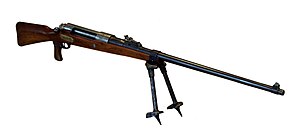Tank rifle M1918
| Tank rifle M1918 | |
|---|---|

|
|
| general information | |
| Military designation: | Tank rifle M1918 |
| Country of operation: | Germany , Poland |
| Developer / Manufacturer: | Mauser |
| Manufacturer country: | Germany |
| Production time: | 1918 to 1919 |
| Weapon Category: | Anti-tank rifle |
| Furnishing | |
| Overall length: | 1670 mm |
| Total height: | 260 mm |
| Total width: | 80 mm |
| Weight: (unloaded) | 16.6 kg |
| Barrel length : | 960 mm |
| Technical specifications | |
| Caliber : | 13 × 92 mm rear |
| Fire types: | Single fire |
| Number of trains : | 8th |
| Twist : | right |
| Visor : | Rear sight and front sight |
| Closure : | Cylinder lock with bolt handle |
| Charging principle: | Single loader |
| Lists on the subject | |
The M1918 tank rifle was a German anti-tank rifle from the First World War and the first anti-tank rifle in the world.
origin
The first time in the Battle of the Somme in September 1916 by the British army used armored vehicles of the type Mark I surprised the German army command. At that time, the German troops had no effective means of defense against this new combat vehicle, known as the tank (Tank was originally the British cover name for their new weapon, but - especially during World War I - it was also used by the Germans to designate the tank) . The tanks could not be approached with machine guns like the MG 08 ; weapons of a considerably larger caliber were urgently required.
technology
The Mauser company received an order for this in 1917. The result was a weapon that looked like an oversized rifle 98 . The shaft was so large that it could no longer be grasped. Instead, a pistol grip was added to ensure a secure hold. The breech was also similar to the 98, with additional locking lugs being attached to the cylinder due to the stronger ammunition. The caliber of the tank rifle was 13.25 mm, for which the new 13 × 92 mm HR cartridge was specially developed.
In battle
At the time it was deployed in 1918, the tank rifle was the world's first weapon that had been specially developed for this purpose. It did not yet have any of the features of later anti- tank rifles such as muzzle brakes or spring buffers; the piston plate was not padded either. The recoil was correspondingly hard. Before the shot, the bipod, which was leaning backwards, had to be anchored in the ground and the butt retracted firmly, otherwise there was a real risk of injury when firing. Due to the sudden and hard shock, the shooter usually got headaches and aching limbs after a few shots and was often no longer able to continue shooting.
The projectiles were able to penetrate 20 to 25 millimeters thick steel armor at a distance of 100 meters. Even if this was sufficient for tanks of the Mark I to Mark V types , even a hard hit rarely resulted in a vehicle being put out of action unless crew members or parts of the propulsion system were hit.
